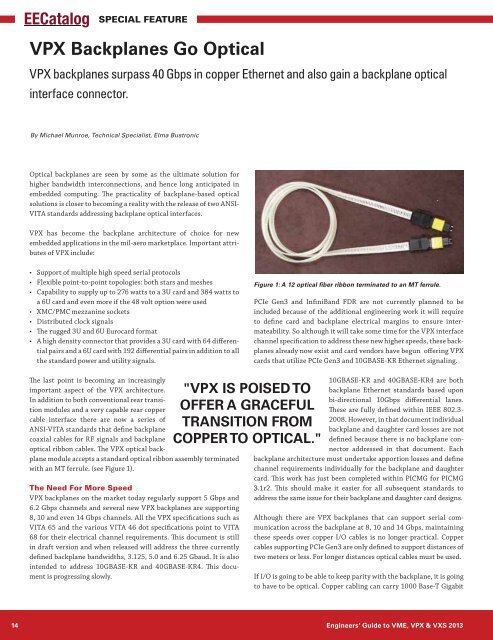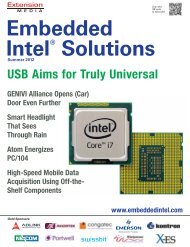the Engineers' Guide to VME, VPX & VXS 2013 - Subscribe
the Engineers' Guide to VME, VPX & VXS 2013 - Subscribe
the Engineers' Guide to VME, VPX & VXS 2013 - Subscribe
Create successful ePaper yourself
Turn your PDF publications into a flip-book with our unique Google optimized e-Paper software.
SPECIAL FEATURE<br />
<strong>VPX</strong> Backplanes Go Optical<br />
<strong>VPX</strong> backplanes surpass 40 Gbps in copper E<strong>the</strong>rnet and also gain a backplane optical<br />
interface connec<strong>to</strong>r.<br />
By Michael Munroe, Technical Specialist, Elma Bustronic<br />
Optical backplanes are seen by some as <strong>the</strong> ultimate solution for<br />
higher bandwidth interconnections, and hence long anticipated in<br />
embedded computing. The practicality of backplane-based optical<br />
solutions is closer <strong>to</strong> becoming a reality with <strong>the</strong> release of two ANSI-<br />
VITA standards addressing backplane optical interfaces.<br />
<strong>VPX</strong> has become <strong>the</strong> backplane architecture of choice for new<br />
embedded applications in <strong>the</strong> mil-aero marketplace. Important attributes<br />
of <strong>VPX</strong> include:<br />
<br />
<br />
<br />
a 6U card and even more if <strong>the</strong> 48 volt option were used<br />
<br />
<br />
<br />
tial<br />
pairs and a 6U card with 192 differential pairs in addition <strong>to</strong> all<br />
<strong>the</strong> standard power and utility signals.<br />
The last point is becoming an increasingly<br />
important aspect of <strong>the</strong> <strong>VPX</strong> architecture.<br />
In addition <strong>to</strong> both conventional rear transition<br />
modules and a very capable rear copper<br />
cable interface <strong>the</strong>re are now a series of<br />
ANSI-VITA standards that define backplane<br />
coaxial cables for RF signals and backplane<br />
optical ribbon cables. The <strong>VPX</strong> optical backplane<br />
module accepts a standard optical ribbon assembly terminated<br />
with an MT ferrule. (see Figure 1).<br />
The Need For More Speed<br />
<strong>VPX</strong> backplanes on <strong>the</strong> market <strong>to</strong>day regularly support 5 Gbps and<br />
6.2 Gbps channels and several new <strong>VPX</strong> backplanes are supporting<br />
8, 10 and even 14 Gbps channels. All <strong>the</strong> <strong>VPX</strong> specifications such as<br />
VITA 65 and <strong>the</strong> various VITA 46 dot specifications point <strong>to</strong> VITA<br />
68 for <strong>the</strong>ir electrical channel requirements. This document is still<br />
in draft version and when released will address <strong>the</strong> three currently<br />
defined backplane bandwidths, 3.125, 5.0 and 6.25 Gbaud. It is also<br />
intended <strong>to</strong> address 10GBASE-KR and 40GBASE-KR4. This document<br />
is progressing slowly.<br />
"<strong>VPX</strong> IS POISED TO<br />
OFFER A GRACEFUL<br />
TRANSITION FROM<br />
COPPER TO OPTICAL."<br />
Figure 1: A 12 optical fiber ribbon terminated <strong>to</strong> an MT ferrule.<br />
PCIe Gen3 and InfiniBand FDR are not currently planned <strong>to</strong> be<br />
included because of <strong>the</strong> additional engineering work it will require<br />
<strong>to</strong> define card and backplane electrical margins <strong>to</strong> ensure intermateability.<br />
So although it will take some time for <strong>the</strong> <strong>VPX</strong> interface<br />
channel specification <strong>to</strong> address <strong>the</strong>se new higher speeds, <strong>the</strong>se backplanes<br />
already now exist and card vendors have begun offering <strong>VPX</strong><br />
cards that utilize PCIe Gen3 and 10GBASE-KR E<strong>the</strong>rnet signaling.<br />
10GBASE-KR and 40GBASE-KR4 are both<br />
backplane E<strong>the</strong>rnet standards based upon<br />
bi-directional 10Gbps differential lanes.<br />
These are fully defined within IEEE 802.3-<br />
2008. However, in that document individual<br />
backplane and daughter card losses are not<br />
defined because <strong>the</strong>re is no backplane connec<strong>to</strong>r<br />
addressed in that document. Each<br />
backplane architecture must undertake apportion losses and define<br />
channel requirements individually for <strong>the</strong> backplane and daughter<br />
card. This work has just been completed within PICMG for PICMG<br />
3.1r2. This should make it easier for all subsequent standards <strong>to</strong><br />
address <strong>the</strong> same issue for <strong>the</strong>ir backplane and daughter card designs.<br />
Although <strong>the</strong>re are <strong>VPX</strong> backplanes that can support serial communication<br />
across <strong>the</strong> backplane at 8, 10 and 14 Gbps, maintaining<br />
<strong>the</strong>se speeds over copper I/O cables is no longer practical. Copper<br />
cables supporting PCIe Gen3 are only defined <strong>to</strong> support distances of<br />
two meters or less. For longer distances optical cables must be used.<br />
If I/O is going <strong>to</strong> be able <strong>to</strong> keep parity with <strong>the</strong> backplane, it is going<br />
<strong>to</strong> have <strong>to</strong> be optical. Copper cabling can carry 1000 Base-T Gigabit<br />
14 Engineers’ <strong>Guide</strong> <strong>to</strong> <strong>VME</strong>, <strong>VPX</strong> & <strong>VXS</strong> <strong>2013</strong>








